Born haber cycle Study guides, Revision notes & Summaries
Looking for the best study guides, study notes and summaries about Born haber cycle? On this page you'll find 50 study documents about Born haber cycle.
Page 4 out of 50 results
Sort by
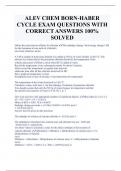
-
ALEV CHEM BORN-HABER CYCLE EXAM QUESTIONS WITH CORRECT ANSWERS 100% SOLVED
- Exam (elaborations) • 6 pages • 2024
-
- £6.44
- + learn more
ALEV CHEM BORN-HABER CYCLE EXAM QUESTIONS WITH CORRECT ANSWERS 100% SOLVED Define the term electron affinity for chlorine The enthalpy change / heat energy change / ΔH for the formation of one mole of (chloride) ions from (chlorine) atoms A 5.00 g sample of potassium chloride was added to 50.0 g of water initially at 20.0 °C. The mixture was stirred and as the potassium chloride dissolved, the temperature of the solution decreased. Start a clock when KCl is added to water Record ...
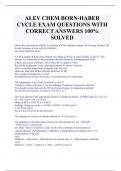
-
ALEV CHEM BORN-HABER CYCLE EXAM QUESTIONS WITH CORRECT ANSWERS 100% SOLVED
- Exam (elaborations) • 6 pages • 2024
-
- £6.44
- + learn more
ALEV CHEM BORN-HABER CYCLE EXAM QUESTIONS WITH CORRECT ANSWERS 100% SOLVED Define the term electron affinity for chlorine The enthalpy change / heat energy change / ΔH for the formation of one mole of (chloride) ions from (chlorine) atoms A 5.00 g sample of potassium chloride was added to 50.0 g of water initially at 20.0 °C. The mixture was stirred and as the potassium chloride dissolved, the temperature of the solution decreased. Start a clock when KCl is added to water Record ...
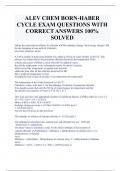
-
ALEV CHEM BORN-HABER CYCLE EXAM QUESTIONS WITH CORRECT ANSWERS 100% SOLVED
- Exam (elaborations) • 6 pages • 2024
-
- £6.44
- + learn more
ALEV CHEM BORN-HABER CYCLE EXAM QUESTIONS WITH CORRECT ANSWERS 100% SOLVED Define the term electron affinity for chlorine The enthalpy change / heat energy change / ΔH for the formation of one mole of (chloride) ions from (chlorine) atoms A 5.00 g sample of potassium chloride was added to 50.0 g of water initially at 20.0 °C. The mixture was stirred and as the potassium chloride dissolved, the temperature of the solution decreased. Start a clock when KCl is added to water Record ...
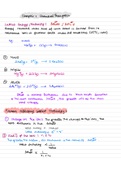
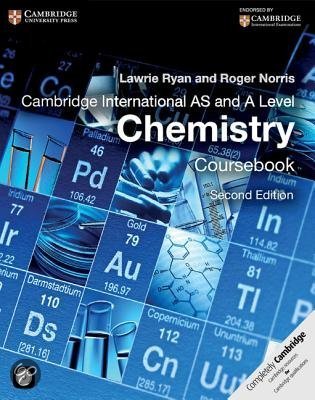
-
energetics and entropy Class notes chemistry Cambridge International AS and A Level Chemistry Coursebook with CD-ROM, ISBN: 9781107638457
- Interview • 28 pages • 2022
-
- £14.34
- + learn more
Definitions of lattice energy, enthalpy of formation, first ionisation energy,second ionisation energy, electron affinity and second electron affinity. Describes the factors affecting lattice enthalpy. Describes the ionisation and electron affinity reactions as exothermic or endothermic. Graphs of both electron affinity and ionisation energy. Diagram of born haber cycle and equation with worked ionship between enthalpy change of tion and lattice energy through hess cycle.Trend of entropy in grou...
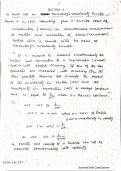
-
Class notes chemistry organic and inorganic including short notes on a.Heisenberg's uncertainty, b.pauli exclusion principle, c. hund's rule, d.Aufbaw's principle, e. De broglie Hypothesis, f.Lattice energy, g.Ionisation energy, g.Electron Affin
- Lecture notes • 86 pages • 2023
-
- £7.09
- + learn more
Including short notes on:- a.Heisenberg's uncertainty, exclusion principle, c. hund's rule, d.Aufbaw's principle, e. De broglie Hypothesis, f.Lattice energy, g.Ionisation energy, g.Electron Affinity, h.Electron Dipole moment........ Long notes are :-a. VSEPR Theory, b.Born Haber cycle, c.Quantum Number, d.Hybridisation, e. Bohr model of atom, f.Resonance
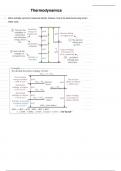
-
A* FULL Summary Notes A-level Chemistry: Thermodynamics
- Summary • 7 pages • 2023
-
- £5.49
- + learn more
Full summary notes on the ‘thermodynamics’ topic in A-level Chemistry. Written by an A* student. Simple, neat and easy to understand. Contains everything you need to know for this topic. Suitable for AQA and OCR exam boards. Very detailed and took about 4 hours to make. Affordable price!
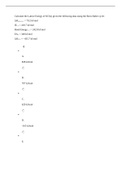
-
CHEM 133-Lesson Questions
- Exam (elaborations) • 25 pages • 2021
- Available in package deal
-
- £8.05
- + learn more
CHEM 133-Lesson Questions Calculate the Lattice Energy of KCl(s) given the following data using the Born-Haber cycle: ΔHsublimation K = 79.2 kJ/mol IE1 K = 418.7 kJ/mol Bond EnergyCl–Cl = 242.8 kJ/mol EACl = 348 kJ/mol ΔHKCl(s) = –435.7 kJ/mol A. 828 kJ/mol B. 707 kJ/mol C. 629 kJ/mol D. -165 kJ/mol E. 288 kJ/mol Answer Key:B Feedback: See Chapter 07 Question 2 of 25 4.0/ 4.0 Points Of the following elements, which has the highest electroneg...

-
AQA A-Level Chemistry Handwritten Notes – Thermodynamics
- Lecture notes • 23 pages • 2023
- Available in package deal
-
- £4.49
- + learn more
Full handwritten notes covering the 'Thermodynamics' chapter of the AQA A-Level Chemistry course. Includes detailed explanations, diagrams and examples.
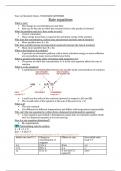
-
AQA A-LEVEL Year 13 Chemistry in FULL
- Summary • 38 pages • 2023
- Available in package deal
-
- £10.89
- + learn more
Entire AS Level chemistry content including Sections 3.1.8 to 3.1.12 of Physical chemistry, sections 3.2.4 to 3.2.6 of Inorganic chemistry and sections 3.3.7 to 3.3.16 of Organic chemistry content (not in that exact order). Notes are compressed and to be treated like flashcards, reading the question and covering the answer. Notes include STANDARD ANSWERS in order to hit the marks. Achieved an A in A-Level chemistry
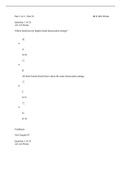
-
CHEM 133-QUESTIONS
- Exam (elaborations) • 27 pages • 2021
-
- £7.65
- + learn more
CHEM 133-QUESTIONS Part 1 of 2 - Part 01 48.0/ 48.0 Points Question 1 of 25 4.0/ 4.0 Points Which bond has the highest bond dissociation energy? A. N≡N B. All three bonds should have about the same dissociation energy. C. N-N D. N=N Feedback: See Chapter 07 Question 2 of 25 4.0/ 4.0 Points Calculate the Lattice Energy of KCl(s) given the following data using the Born-Haber cycle: ΔHsublimation K = 79.2 kJ/mol IE1 K = 418.7 kJ/mol Bond EnergyCl–Cl = ...

How much did you already spend on Stuvia? Imagine there are plenty more of you out there paying for study notes, but this time YOU are the seller. Ka-ching! Discover all about earning on Stuvia


